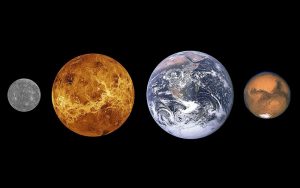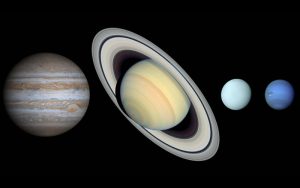The Solar System has 8 planets, which were formed around 4.5 billion years ago, shortly after the emergence of our Sun. Earth, the 3rd planet in distance from the Sun, is certainly the most notable for being our home planet. and the only one we know of (so far) capable of sustaining life. The planets are divided into 2 categories (rocky and gaseous), detailed below, while you can find specific information about each planet in their respective subsections.
 The rocky planets of the Solar System are Mercury, Venus, Land and MarsThey are so named because their surface is solid, composed of rocks that have been joined together from many smaller rocks, through a process called accretion. The area that corresponds to the rocky planets is also called the "inner Solar System", and also represents our closest "neighborhood", which is why most space missions have been dedicated to exploring its components, with special emphasis on Mars.
The rocky planets of the Solar System are Mercury, Venus, Land and MarsThey are so named because their surface is solid, composed of rocks that have been joined together from many smaller rocks, through a process called accretion. The area that corresponds to the rocky planets is also called the "inner Solar System", and also represents our closest "neighborhood", which is why most space missions have been dedicated to exploring its components, with special emphasis on Mars.
Rocky planets, on the other hand, are clearly smaller in size compared to their gaseous peers, and have a much smaller number of satellites overall: Mercury and Venus have none, while the Earth has one (the Moon). , and Mars has two (Phobos and Deimos).
 The gaseous planets of the Solar System are Jupiter, Saturn, Uranus and NeptuneThey are named this because their surface is gaseous, and the gases that make them up have condensed and swirled through a process called accretion. The area that corresponds to the gaseous planets is also called the "outer Solar System" and also represents our most distant "neighborhood", which is why only a few space missions have been dedicated to exploring its components and capturing some images (especially of its natural satellites), among which the Cassini-Huygens mission stands out.
The gaseous planets of the Solar System are Jupiter, Saturn, Uranus and NeptuneThey are named this because their surface is gaseous, and the gases that make them up have condensed and swirled through a process called accretion. The area that corresponds to the gaseous planets is also called the "outer Solar System" and also represents our most distant "neighborhood", which is why only a few space missions have been dedicated to exploring its components and capturing some images (especially of its natural satellites), among which the Cassini-Huygens mission stands out.
The gaseous planets, on the other hand, are clearly larger in size compared to their rocky peers, and have a much larger number of satellites: If we add all the natural satellites of Jupiter, Saturn, Uranus and Neptune, we obtain more than 200 objects (known to date).

